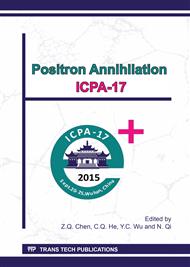[1]
C.A. Wert, Hydrogen in metals, Top. Appl. Phys. 29 (1978) 305-330.
Google Scholar
[2]
Y.S. Bordulev, R.S. Laptev, V.N. Kudiyarov, A.M. Lider, Investigation of commercially pure titanium structure during accumulation and release of hydrogen by means of positron lifetime and electrical resistivity measurements, Adv. Mater. Res. 880 (2014).
DOI: 10.4028/www.scientific.net/amr.880.93
Google Scholar
[3]
R.S. Laptev, Y.S. Bordulev, V.N. Kudiyarov, A.M. Lider, G.V. Garanin, Positron annihilation spectroscopy of defects in commercially pure titanium saturated with hydrogen, Adv. Mater. Res. 880 (2014) 134-140.
DOI: 10.4028/www.scientific.net/amr.880.134
Google Scholar
[4]
Y. Fukai, N. Okuma, Formation of superabundant vacancies in Pd hydride under high hydrogen pressures, Phys. Rev. Lett. 73, 12 (1994) 1640-1643.
DOI: 10.1103/physrevlett.73.1640
Google Scholar
[5]
Y. Shirai, H. Araki, T. Mori, W. Nakamura, K. Sakaki, Positron annihilation study of lattice defects induced by hydrogen absorption in some hydrogen storage materials, J. Alloy Compd. 330 (2002) 125-131.
DOI: 10.1016/s0925-8388(01)01635-8
Google Scholar
[6]
J. Cizek, I. Prochazka, S. Danis, M. Cieslar, G. Brauer, W. Anwand, R. Kirchheim, A. Pundt, Hydrogen-induced defects in niobium, J. Alloy Compd. 446 (2007) 479-483.
DOI: 10.1016/j.jallcom.2006.11.105
Google Scholar
[7]
J. Cizek, I. Prochazka, F. Becvar, R. Kuzel, M. Cieslar, G. Brauer, W. Anwand, R. Kirchheim, A. Pundt, Hydrogen-induced defects in bulk niobium, Phys. Rev. B. 69, 22 (2004) 224106.
DOI: 10.1103/physrevb.69.224106
Google Scholar
[8]
R. Krause-Rehberg, H.S. Leipner. Positron annihilation in semiconductors: Defect Studies, third ed., Berlin Heidelberg, New York (2003).
Google Scholar
[9]
V.I. Grafutin, E.P. Prokop'ev, Positron annihilation spectroscopy in materials structure studies, Phys. Usp. 45, 1 (2002) 59-74.
DOI: 10.1070/pu2002v045n01abeh000971
Google Scholar
[10]
A. Dupasquier, A.P. Mills, Positron spectroscopy of solids, IOS Press. 125 (1995).
Google Scholar
[11]
G.J.C. Carpenter, H.T. Easterday, B.T.A. McKee, A study of defect states in neutron-irradiated zirconium using positron annihilation spectroscopy, J. Nucl. Mater. 116, 2 (1983) 277-286.
DOI: 10.1016/0022-3115(83)90113-7
Google Scholar
[12]
R. Laptev, A. Lider, Yu. Bordulev, V. Kudiiarov, G. Garanin, Hydrogenation-induced microstructure changes in titanium, J. Alloys. Compd. 645 (2015) S193-S195.
DOI: 10.1016/j.jallcom.2014.12.257
Google Scholar
[13]
V.N. Kudiiarov, L.V. Gulidova, N.S. Pushilina, A.M. Lider, Application of automated complex Gas Reaction Controller for hydrogen storage materials investigation, Adv. Mater. Res. 740 (2013) 690-693.
DOI: 10.4028/www.scientific.net/amr.740.690
Google Scholar
[14]
D. Giebel, J. Kansy, A new version of LT program for positron lifetime spectra analysis, Materials Science Forum. 1073, 666 (2010) 138-141.
DOI: 10.4028/www.scientific.net/msf.666.138
Google Scholar
[15]
The SP-program. Electronic source, http: /www. ifj. edu. pl/~mdryzek/page_r18. html.
Google Scholar
[16]
A. San-Martin, F.D. Manchester, The H− Ti (Hydrogen-Titanium) system, Bulletin of alloy phase diagrams. 8, 1 (1987) 30-42.
DOI: 10.1007/bf02868888
Google Scholar
[17]
K.P. Arefyev, O.V. Boev, O.N. Imas, A.M. Lider, A.S. Surkov, I.P. Chernov, Annihilation of positrons in hydrogen-saturated titanium, Phys. Solid State. 45, 1(2003) 1-5.
DOI: 10.1134/1.1537399
Google Scholar
[18]
H. Rajainmäki, S. Linderoth, H.E. Hansen, R.M. Nieminen, Defect recovery and hydrogen-vacancy interactions in nickel between 20 and 650 K, Journal of Physics F: Metal Physics. 18, 6 (1988) 1109-1118.
DOI: 10.1088/0305-4608/18/6/014
Google Scholar
[19]
J. Čížek, I. Procházka, S. Daniš, G. Brauer, W. Anwand, R. Gemma, E. Nikitin, R. Kirchheim, A. Pundt, R.K. Islamgaliev, Hydrogen-vacancy complexes in electron-irradiated niobium, Phys. Rev. B. 79, 5 (2009) 054108.
DOI: 10.1103/physrevb.79.054108
Google Scholar
[20]
K. Sakaki, H. Araki, Y. Shirai, Recovery of Hydrogen Induced Defects and Thermal Desorption of Residual Hydrogen in LaNi5, Mater. Trans. 43, 7 (2002) 1494-1497.
DOI: 10.2320/matertrans.43.1494
Google Scholar
[21]
S.E. Kulkova, O.N. Muryzhnikova, K.A. Beketov, Electron and positron characteristics of group IV metal dihydrides, Int. J. Hydrogen Energ. 21, 11 (1996) 1041-1047.
DOI: 10.1016/s0360-3199(96)00100-0
Google Scholar


